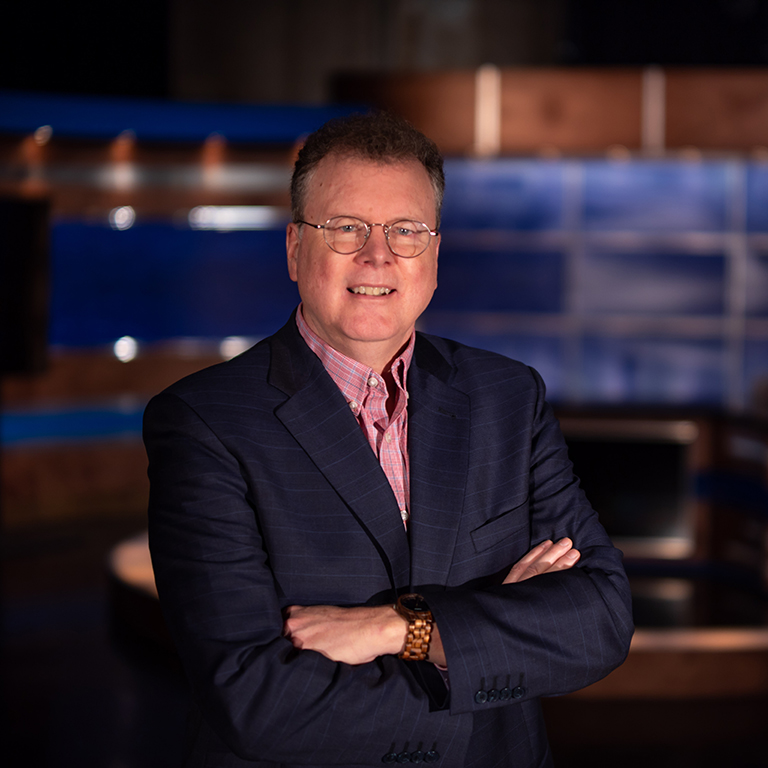“I’m amazed at the quality of our programming,” he said. “Our music programming is obviously a testament to our staff, the Jacobs School, and the people who appreciate music here. Classical, jazz, soul, R&B … I’m amazed at how broad the music programming is and how many shows are recorded in Bloomington or on campus. ‘The Ernie Pyle Experiment!’ is as good as any podcast I’ve heard, and there’s a fascinating documentary on round barns and the origins of agriculture in Indiana. ‘Earth Eats’ and ‘A Moment of Science’ are incredibly well-done podcasts as well. Basically, I’m consuming as much of our content as I can.”
Of course, the technology that makes digital onboarding so streamlined is the same tech that’s been steadily driving media companies the world over to rethink programming and distribution for digital-first audiences accustomed to instant information that’s easily shareable across multiple platforms. Brad is stepping into his position at Indiana Public Media at a time when the media environment both presents exciting opportunities to reach and inform audiences in different ways and also makes it easier for anyone to spread misinformation. This further spotlights the need to preserve journalistic integrity and support the impartial, thoroughly researched information that makes public media a crucial part of American democracy.
Brad brings with him the skill and perspective needed to work through these challenges. Most recently, he served as the president and CEO of WNIN Public Media in Evansville, Ind. His media background includes the founding and managing of several TV and media companies; working with state, federal and community leaders to increase public funding and station engagement; and development and management of complex budgets.
When we spoke, Brad was busy learning all he could at IU and RTV, his days full of Zoom meetings with campus leaders, colleagues, and RTV staff, as he began to think through a vision for the future. (“I feel like I’m rushing for a Greek house,” he joked after running down a list of that week’s meetings with the Jacobs School of Music, the Media School and the Office of the Provost.) Part of Brad’s vision will be to further integrate the programming efforts and communications resources of Indiana Public Media into other campus media activities as IU Bloomington continues to further expand its educational programs in new and traditional forms of media.
And while there will be far more to report about concrete plans for RTV heading into the fall of 2021, for now — as vaccinations take hold and we can see campus life, hopefully, returning to a semblance of normalcy — let’s get to know Brad. He can be reached at bdkimmel@iu.edu.
Q: Any specific plans for Indiana Public Media that you can share?
A: Currently, about 70 percent of Indiana Public Media coverage is outside of Bloomington, so I see an opportunity to grow local news coverage. I also want to expand our relationship with public media affiliates in the region. NPR has regional journalism hubs, and we could certainly be that hub for the Midwest. I read several newspapers every day, but unfortunately, if you look at newspapers, they’re struggling — there are fewer printing presses — and people are getting more news from other sources. The independent voice is very important. I’m a big advocate for providing the information and letting people draw their own conclusions.
Q: Can you describe the connection between WFIU to NPR and some of the podcasts people listen to every day? How does giving to local stations support NPR in general?
A: Some people think that the government provides our funding. We do get some public money, but each year we need to make up more than 2 million through donor support. We also get some money when our programming goes into larger syndication. We have a number of our music programs and documentaries that we distribute nationally each year.
In the old days, people just wrote a check to an organization, but now people are more interested in giving to specific projects and causes; donors are looking for different ways to connect to organizations. They want to know how their money is making a difference and how it connects with the community. So, I’m always happy to discuss the ways we use donor funds to produce the local content the public tells us they love.
Q: How do you plan to give more voice to diverse talent and those who haven’t always been represented in media?
A: Getting more diverse voices into our staff and programming is a priority that will be written into our strategic plan. We share the larger IU mission to prioritize Diversity, Equity, and Inclusion in hiring practices and story content. It also helps that CBP, PBS and NPR are supporting local stations by providing training and support.
Q: Thoughts about how to engage younger audiences with public media content?
A: This is a key question for public media. The way younger people consume media is so different from their parents and grandparents. And in some ways, the social media platforms, like Facebook, are the new public media. So, as we do our strategic planning, we will be looking for opportunities to serve younger audiences that are not being served by commercial media companies. That has always been our mission from our founding.
Q: What about news coverage? What are your thoughts about the state of journalism?
A: First of all, I’m very proud of our news organization. We work hard to present quality journalism to the public that is factually correct and free from personal opinions. Unfortunately, this is not the norm anymore. People are getting news from an ever-increasing list of sources with varied motivations. A lot of comedy and news has melded together, especially in late-night comedy, so younger people know the issues, but they are often given the facts by the comics themselves, wrapped in the comics’ opinions. And I do worry about tribalism. No matter what environment you’ve been brought up in, you have to be willing to listen to other points of view and maybe even be OK with changing your mind, which I know is a lot of work. It’s hard to understand people until you’re in their shoes, and accurate, impartial news can play a big part in helping people understand other perspectives.
Q: What are your thoughts on the many parodies of public media in the culture on shows such as Saturday Night Live (Schweddy Balls), Parks & Rec (Jazz+Jazz=Jazz), Portlandia (NPR Podcast), and the Ken Burns Parody, Ken Burns’ Ken Burns? Is all press good press to stay relevant and “in the conversation”?
A: When it’s not mean or nasty, or meant to tear down an organization or person—if we can laugh at ourselves—anytime someone draws attention to public media, it’s usually good. People hate to be ignored. That’s a very human thing to be aware of. I was watching a rerun of Big Bang Theory that featured public media that was done in jest and it was fun.
Q: What content has gotten you through the pandemic?
A: The Schitt’s Creek phenomenon is a great example of a show that reflects our times, and the Moira Rose character (Catherine O’Hara) is brilliant. Without her, it wouldn’t be the same show. I also love documentaries, The Crown, All Creatures Great and Small on Masterpiece.
Q: Any pets?
A: We love dogs. We’ve always had shelter dogs. Abbi is a 25-pound cattle dog and terrier from the Warrick County Humane Society near Evansville. One of the things my wife and I already enjoy about Bloomington are the numerous walking trails. We always look forward to taking Abbi on a long walk on the Clear Creek Trail near our house.



